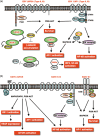Gamma-herpesviruses and cellular signaling in AIDS-associated malignancies
- PMID: 17640300
- PMCID: PMC11158765
- DOI: 10.1111/j.1349-7006.2007.00555.x
Gamma-herpesviruses and cellular signaling in AIDS-associated malignancies
Abstract
gamma-Herpesviruses, Epstein-Barr virus (EBV/HHV-4) and Kaposi's sarcoma-associated herpesvirus (KSHV/HHV-8), are involved in human carcinogenesis, particularly in immunocompromised patients. Virus-associated malignancies are becoming of significant concern for the mortality of long-lived immunocompromised patients, and therefore, research of advanced strategies for AIDS-related malignancies is an important field in cancer chemotherapy. Detailed understanding of the EBV and KSHV lifecycle and related cancers at the molecular level is required for novel strategies of molecular-targeted cancer chemotherapy. The present review gives a simple outline of the functional interactions between KSHV- and EBV-viral gene products and host cell deregulated signaling pathways as possible targets of chemotherapy against AIDS-related malignancies.
Figures





References
-
- Boshoff C, Weiss R. AIDS‐related malignancies. Nat Rev Cancer 2002; 2: 373–82. - PubMed
-
- Damania B. Oncogenic gamma‐herpesviruses: comparison of viral proteins involved in tumorigenesis. Nat Rev Microbiol 2004; 2: 656–68. - PubMed
-
- Chang Y, Cesarman E, Pessin MS et al . Identification of herpesvirus‐like DNA sequences in AIDS‐associated Kaposi's sarcoma. Science 1994; 266: 1865–9. - PubMed
-
- Boshoff C, Schulz TF, Kennedy MM et al . Kaposi's sarcoma‐associated herpesvirus infects endothelial and spindle cells. Nat Med 1995; 1: 1274–8. - PubMed
Publication types
MeSH terms
LinkOut - more resources
Full Text Sources
Medical

